
In the Boer Republics of 19th century South Africa, a burgher was a fully enfranchised citizen. Burgher rights were restricted to white men, in particular Boers.

In the Boer Republics of 19th century South Africa, a burgher was a fully enfranchised citizen. Burgher rights were restricted to white men, in particular Boers.
Historically Burgher refers to a non-slave or serf citizen of a town or city, typically a member of the wealth bourgeoisie. (See also Burgher (title)).
In South Africa, the word has its origins from the term free burghers. After the establishment of the settlement at the Cape by the Dutch East India Company (VOC) several servants were issued with free papers in 1657 relieving them from their service to the Company. These people were referred to as the Free Burghers. Free burgher status included privileges such as land ownership and making use of the land to farm and supply produce to the Company usually at fixed rates. [1]
The free burghers who settled permanently in the Cape area brought about the inception of the Boers who migrated further into the interior of South Africa. Several expansions such as the Trekboers and the Great trek [1] eventually led to the establishment of the Boer republics in 1852. Typically a citizen of the Orange Free State would be referred to as a 'Burgher of the Free State'. [2]
The rights to political representation and the ownership of property were collectively referred to as "burgher rights". [3] In the Orange Free State (1854–1902), the constitution restricted burgher rights to white male residents only. The coloured people (those of mixed ancestry and who were mostly servants) had some rights regarding property but they were not burghers. [3] The South African Republic, or Transvaal (1852–1902), gave burgher rights to white males only and explicitly barred their extension to "persons of colour". [3] A bill passed in the Transvaal in 1858 permitted "no equality between the white and coloured inhabitants, neither in Church nor in State". [3] Burghers were "citizen-soldiers" who, between the ages of 16 and 60, were obliged to serve without pay in the republic's commandos, providing their own horse and rifle, 30 rounds of ammunition and their own rations for the first ten days. [4] Most of them were Boers. [5]
Following the discovery of diamonds and gold in the Boer Republics and their environs in the 1870s and 1880s, white immigrants of mostly British stock began moving to the region in large numbers. The Boers referred to these people as uitlanders ("out landers"). [6] The uitlanders demanded full burgher rights in the Transvaal, but the local government under President Paul Kruger was unwilling to grant these, surmising that the sheer number of uitlanders might imperil the republic's independence. [7] The Irish Transvaal Brigade was established days before the outbreak of the Second Boer War and initially consisted of Irishmen who worked in the Witwatersrand. These volunteers were given full citizenship and became Burghers of the Boer republics. Under the leadership of John MacBride, the brigade was strengthened by volunteers traveling from Ireland via Delagoa Bay into South Africa. [8]
The uitlander problem and the associated tensions between the South African Republic and Britain led to the Jameson Raid of 1895–96 and ultimately the Second Boer War of 1899–1902. [9] Following the British victory in the latter and the Treaty of Vereeniging, the Free State and the Transvaal were annexed by Britain as the Orange River Colony and Transvaal Colony. [10]

The Burgher Memorial near Ladysmith were unveiled in 1979 in memory of the 781 Burghers who died during the Second Boer War. The memorial contains the remains of 310 burghers who died during battles in Natal. Six structures symbolizing hands reaching upwards and one hand pointing downwards are presented. [11]
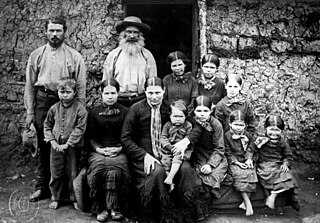
Boers are the descendants of the proto Afrikaans-speaking Free Burghers of the eastern Cape frontier in Southern Africa during the 17th, 18th, and 19th centuries. From 1652 to 1795, the Dutch East India Company controlled Dutch Cape Colony, but the United Kingdom incorporated it into the British Empire in 1806. The name of the group is derived from Trekboer then later "boer", which means "farmer" in Dutch and Afrikaans.

The South African Republic, also known as the Transvaal Republic, was an independent Boer republic in Southern Africa which existed from 1852 to 1902, when it was annexed into the British Empire as a result of the Second Boer War.

The Second Boer War, also known as the Boer War, the Anglo–Boer War, or the South African War, was a conflict fought between the British Empire and the two Boer Republics over the Empire's influence in Southern Africa from 1899 to 1902.

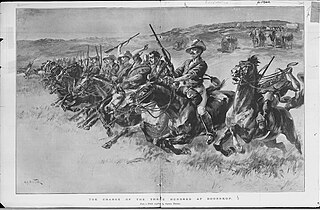
The Jameson Raid was a botched raid against the South African Republic carried out by British colonial administrator Leander Starr Jameson, under the employment of Cecil Rhodes. It involved 500 British South Africa Company police launched from Rhodesia over the New Year weekend of 1895–96. Paul Kruger, for whom Rhodes had great personal hatred, was president of the South African Republic at the time. The raid was intended to trigger an uprising by the primarily British expatriate workers in the Transvaal but it failed. The workers were referred to as The Johannesburg Conspirators. They were expected to recruit an army and prepare for an insurrection; however, the raid was ineffective, and no uprising took place. The results included embarrassment of the British government; the replacement of Cecil Rhodes as prime minister of the Cape Colony; and the strengthening of Boer dominance of the Transvaal and its gold mines. The raid was a contributory cause of the Anglo-Boer War (1899–1902).

Stephanus Johannes Paulus Kruger was a South African politician. He was one of the dominant political and military figures in 19th-century South Africa, and State President of the South African Republic from 1883 to 1900. Nicknamed Oom Paul, he came to international prominence as the face of the Boer cause—that of the Transvaal and its neighbour the Orange Free State—against Britain during the Second Boer War of 1899–1902. He has been called a personification of Afrikanerdom, and remains a controversial figure; admirers venerate him as a tragic folk hero.

The Orange Free State was an independent Boer sovereign republic under British suzerainty in Southern Africa during the second half of the 19th century, which ceased to exist after it was defeated and surrendered to the British Empire at the end of the Second Boer War in 1902. It is one of the three historical precursors to the present-day Free State province.
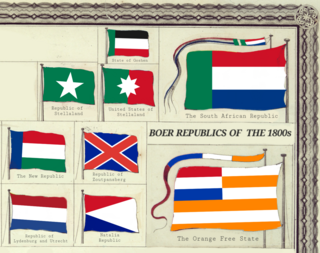
The Boer republics were independent, self-governing republics formed by Dutch-speaking inhabitants of the Cape Colony and their descendants. The founders – variously named Trekboers, Boers and Voortrekkers – settled mainly in the middle, northern, north-eastern and eastern parts of present-day South Africa. Two of the Boer Republics achieved international recognition and complete independence: the South African Republic and the Orange Free State. The republics did not provide for the separation of church and state, initially allowing only the Dutch Reformed Church, and later also other Protestant churches in the Calvinist tradition. The republics came to an end after the Second Boer War of 1899–1902, which resulted in British annexation and later incorporation of their lands into the Union of South Africa.
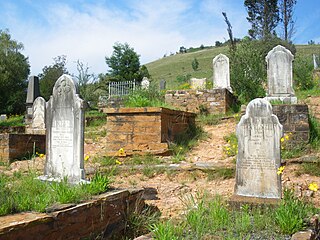
Uitlander, Afrikaans for "foreigner", was a foreign migrant worker during the Witwatersrand Gold Rush in the independent Transvaal Republic following the discovery of gold in 1886. The limited rights granted to this group in the independent Boer Republics was one of the contributing factors behind the Second Boer War.
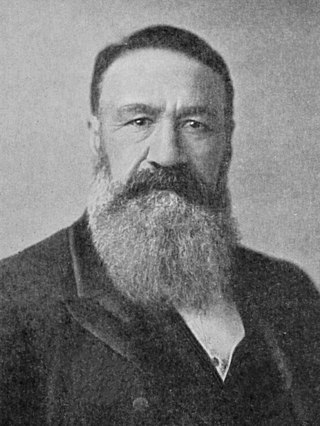
Petrus Jacobus Joubert, better known as Piet Joubert, was Commandant-General of the South African Republic from 1880 to 1900. He also served as Vice-President to Paul Kruger from May 1883 to October 1884 and from May 1896 until his death. He served in First Boer War, Second Boer War, and the Malaboch War.

The Treaty of Vereeniging was a peace treaty, signed on 31 May 1902, that ended the Second Boer War between the South African Republic and the Orange Free State, on the one side, and the United Kingdom on the other.

Field Marshal Jan Christian Smuts, OM, CH, ED, KC, FRS was a prominent South African and Commonwealth statesman, military leader, and philosopher. He served as a Boer General during the Boer War, a British General during the First World War and was appointed Field Marshal by King George VI during the Second World War. In addition to various cabinet appointments, he served as Prime Minister of the Union of South Africa from 1919 until 1924 and from 1939 until 1948. From 1917 to 1919 he was one of five members of the British War Cabinet, helping to create the Royal Air Force. He played a leading part in the post-war settlements at the end of both world wars, making significant contributions towards the creation of the League of Nations and the United Nations. He did much to redefine the relationship between Britain and the Dominions and Colonies, leading to the formation of the British Commonwealth.

The Bloemfontein Conference was a meeting that took place at the railway station of Bloemfontein, capital of the Orange Free State from 31 May until 5 June 1899. The main issue dealt with the status of British migrant workers called "Uitlanders", who mined the gold fields in Transvaal.

During the Napoleonic Wars, the Cape Colony was annexed by the British and officially became their colony in 1815. Britain encouraged settlers to the Cape, and in particular, sponsored the 1820 Settlers to farm in the disputed area between the colony and the Xhosa in what is now the Eastern Cape. The changing image of the Cape from Dutch to British excluded the Dutch farmers in the area, the Boers who in the 1820s started their Great Trek to the northern areas of modern South Africa. This period also marked the rise in power of the Zulu under their king Shaka Zulu. Subsequently, several conflicts arose between the British, Boers and Zulus, which led to the Zulu defeat and the ultimate Boer defeat in the Second Anglo-Boer War. However, the Treaty of Vereeniging established the framework of South African limited independence as the Union of South Africa.

The South African Wars, including – and commonly referred to as – the Confederation Wars, were a series of wars that occurred in the southern portion of the African continent between 1879 and 1915. Ethnic, political, and social tensions between European colonial powers and indigenous Africans led to increasing hostilities, culminating in a series of wars and revolts, which had lasting repercussions on the entire region. A key factor behind the growth of these tensions was the pursuit of commerce and resources, both by countries and individuals, especially following the discoveries of diamonds in the region in 1867 and gold in 1862.
The Drifts Crisis of 1895 was an imperial-republican confrontation in South Africa that took place in September and October 1895. It was precipitated by the closing of fords, which in South Africa were known as 'drifts'. The Crisis has traditionally been seen as the precursor to the Jameson Raid and the uncompromising policies of High Commissioner for Southern Africa Alfred Milner which followed, and eventually led to the Second Anglo-Boer War. Historians generally regard the conflicts to have been between the Cape Colony and the South African Republic (SAR), informally known as the Transvaal Republic.

The Transvaal Civil War was a series of skirmishes during the early 1860s in the South African Republic, or Transvaal, in the area now comprising the Gauteng, Limpopo, Mpumalanga, and North West provinces of South Africa. It began after the British government had recognised trekkers living in the Transvaal as independent in 1854. The Boers divided into numerous political factions. The war ended in 1864, when an armistice treaty was signed under a karee tree south of the site of the later town of Brits.

The military history of Australia during the Boer War is complex, and includes a period of history in which the six formerly autonomous British Australian colonies federated to become the Commonwealth of Australia. At the outbreak of the Second Boer War, each of these separate colonies maintained their own, independent military forces, but by the cessation of hostilities, these six armies had come under a centralised command to form the Australian Army.
The Battle of Naauwpoort Nek refers to a clash between the Trekboers and Basotho warriors on 29 September 1865. Naauwpoort lies immediately to the north of the Free State town of Clarens.

General Jacobus Philippus Snyman was one of the dominant military figures in the South African Republic during the 19th century. He was the District Commissioner, Native Commissioner, and Commandant for the Marico district and led the Rustenburg and Marico commandos during the Second Boer War. Nicknamed Hamerkop, Snyman came to international prominence as the military commander at the Siege of Mafeking from November 1899 to May 1900.
Notes
Bibliography